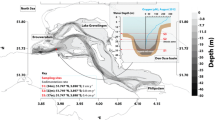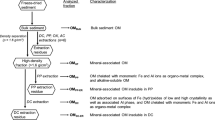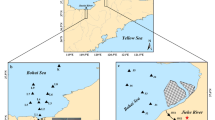Abstract
Purpose
This study explored the effects of anoxia on adsorbed Si dynamics in surface sediments. While the effects of anoxia on the adsorption and release of phosphorus (P) have been studied frequently, its effects on adsorbed silicon (Si) are commonly ignored, despite the similarities between the elements. The study addresses the theory that as both Si and P produce anionic ligands, processes that affect adsorbed P and its release could also affect Si and its release.
Materials and methods
Two main procedures were conducted: A sequential extraction procedure composed of (1) water, (2) 0.46 M sodium chloride, (3) 0.11 M sodium dithionite, (4) 0.1 M sodium hydroxide and (5) 0.5 M hydrochloric acid extractions, and a long-term release dynamics experiment (RDE) lasting 28 days. Both were conducted using seven sediment samples of different composition.
Results and discussion
Silicon behaved differently than P under anoxic conditions. Although anoxia generally causes increased release of Fe-bound P due to Fe3+ reduction, the release of Si decreased under anoxic conditions in the loosely sorbed and redox-sensitive fractions of the sediments. The long-term experiment (RDE) showed that Si release was time-dependent and slower under anoxic than oxic conditions. Resorption to Al oxides and the formation of colloidal mixed Fe-Si oxides are possible reasons for these results. There were, however, also some indications that anoxic conditions enhanced biogenic Si (BSi) and mineral Si dissolution.
Conclusions
Anoxia clearly affects Si sorption processes, but it may have both negative (e.g. increased resorption preventing P adsorption) and positive (e.g. enhanced BSi dissolution, increasing dissolved Si concentration in water) effects on the release of Si. More investigations dealing with the subject are needed.





Similar content being viewed by others
References
Alexandre A, Meunier J, Colin F, Koud J (1997) Plant impact on the biogeochemical cycle of silicon and related weathering processes. Geochim Cosmochim Acta 61:677–682
Anderson PR, Benjamin MM (1985) Effect of silicon on the crystallization and adsorption properties of ferric oxides. Environ Sci Technol 19:1048–1053
Bauerfeind E, Bodungen Bv (2006) Underestimation of biogenic silicon flux due to dissolution in sediment trap samples. Mar Geol 226:297–306
Belias C, Dassenakis M, Scoullos M (2007) Study of the N, P and Si fluxes between fish farm sediment and seawater. Results of simulation experiments employing a benthic chamber under various redox conditions. Mar Chem 103:266–275
Brinkman R (1970) Ferrolysis, a hydromorphic soil forming process. Geoderma 3:199–206
Brzezinski MA, Villareal TA, Lipschultz F (1998) Silica production and the contribution of diatoms to new and primary production in the central North Pacific. Mar Ecol Prog Ser 167:89–104
Chakravarti IM, Laha RG, Roy J (1967) Handbook of Methods of Applied Statistics. Volume I. John Wiley and Sons, New York, pp 392–394
Danielsson Å (2014) Influence of hypoxia on silicate concentrations in the Baltic Proper (Baltic Sea). Boreal Environ Res 19:267–280
DeMaster DJ (1981) The supply and accumulation of silica in the marine environment. Geochim Cosmochim Acta 45:1715–1732
Einsele W (1936) Über die Beziehungen des Eisenkreislaufs zum Phosphatekreislauf im eutrophen See. Arch Hydrobiol 29:664–686
Fraysse F, Pokrovsky O, Schott J, Meunier J (2009) Surface chemistry and reactivity of plant phytoliths in aqueous solutions. Chem Geol 258:197–206
Hartikainen H, Pitkanen M, Kairesalo T, Tuominen L (1996) Co-occurrence and potential chemical competition of phosphorus and silicon in lake sediment. Water Res 30:2472–2478
Hiemenz PC (1986) Principles of Colloid and Surface Chemistry. Marcel Dekker, New York
Hingston FJ, Atkinson RJ, Posner AM, Quirk JP (1967) Specific adsorption of anions. Nature 215:1459–1469
Holford ICR, Patrick WH Jr (1979) Effects of reduction and pH changes on phosphate sorption and mobility in an acid soil. Soil Sci Soc Am J 43:292–297
Jackson ML, Lim CH, Zelazny LW (1986) Oxides, hydroxides, and aluminosilicates. In: Klute A (ed) Methods of Soil Analysis. Part 1. 2nd ed. Agronomy 9:101–150
Jensen HS, Thamdrup B (1993) Iron bound phosphorus in marine sediments as measured by bicarbonate-dithionite extraction. Hydrobiologia 253:47–59
Koning E, Epping E, Van Raaphorst W (2002) Determining biogenic silica in marine samples by tracking silicate and aluminium concentrations in alkaline leaching solutions. Aquat Geochem 8:37–67
Lee SO, Tran T, Jung BH, Kim SJ, Kim MJ (2007) Dissolution of iron oxide using oxalic acid. Hydrometallurgy 87:91–99
Lehtimäki M, Tallberg P, Siipola V (2013) Seasonal Dynamics of Amorphous Silica in Vantaa River Estuary. Silicon 5:35–51
Loucaides S, Michalopoulos P, Presti M, Koning E, Behrends T, Van Cappellen P (2010) Seawater-mediated interactions between diatomaceous silica and terrigenous sediments: results from long-term incubation experiments. Chem Geol 270:68–79
Lukkari K, Hartikainen H, Leivuori M (2007a) Fractionation of sediment phosphorus revisited. I: fractionation steps and their biogeochemical basis. Limnol Oceanogr Methods 5:433–444
Lukkari K, Leivuori M, Hartikainen H (2007b) Fractionation of sediment phosphorus revisited: II. Changes in phosphorus fractions during sampling and storing in the presence or absence of oxygen. Limnol Oceanogr Methods 5:445–456
Manahan SE (1994) Environmental Chemistry. Lewis Publishers, Boca Raton, FL
Mayer TD, Jarrell WM (2000) Phosphorus sorption during iron(II) oxidation in the presence of dissolved silica. Water Res 34:3949–3956
Mayer TD, Jarrell WM (1996) Formation and stability of iron(II) oxidation products under natural concentrations of dissolved silica. Water Res 30:1208–1214
Meng X, Letterman RD (1993) Effect of component oxide interaction on the adsorption properties of mixed oxides. Environ Sci Technol 27:970–975
Michalopoulos P, Aller RC (2004) Early diagenesis of biogenic silica in the Amazon delta: alteration, authigenic clay formation, and storage. Geochim Cosmochim Acta 68:1061–1085
Mortimer CH (1941) The Exchange of Dissolved Substances Between Mud and Water in Lakes I, II. J Ecol 29:280–329
Mullin J, Riley J (1955) The colometric determination of silicate with special reference to sea and natural waters. Analytica Chimica Acta 12:162–176
Panias D, Taxiarchou M, Paspaliaris I, Kontopoulos A (1996) Mechanisms of dissolution of iron oxides in aqueous oxalic acid solutions. Hydrometallurgy 42:257–265
Papush L, Danielsson Å, Rahm L (2009) Dissolved silica budget for the Baltic Sea. J Sea Res 62:31–41
Patrick WH Jr, Khalid RA (1974) Phosphate release and sorption by soils and sediments: effect of aerobic and anaerobic conditions. Science 186:53–55
Piispanen JK, Sallanko JT (2011) Effect of silica on iron oxidation and floc formation. J Environ Sci Health, Part A 46:1092–1101
R Core Team (2013) R: A language and environment for statistical computing
Ragueneau O, Conley DJ, Leynaert A, Longphuirt SN, Slomp CP (2006) Role of diatoms in silicon cycling and coastal marine food webs. In: Ittecot V, Unger D, Humborg C, Tac AN (eds) The silicon cycle: human perturbations and impacts on aquatic systems, vol 66, SCOPE., pp 163–195
Reynolds C (1984) The ecology of freshwater phytoplankton. Cambridge University Press, Cambridge
Roden EE, Edmonds JW (1997) P mobilization in Fe-rich anaerobic sediments. Microbial Fe(III) oxide reduction versus iron-sulfide formation. Arch Hydrobiol 139:347–378
Saccone L, Conley DJ, Koning E, Sauer D, Sommer M, Kaczorek D, Blecker SW, Kelly EF (2007) Assessing the extraction and quantification of amorphous silica in soils of forest and grassland ecosystems. Eur J Soil Sci 58:1446–1459
Sauer D, Saccone L, Conley DJ, Herrmann L, Sommer M (2006) Review of methodologies for extracting plant-available and amorphous Si from soils and aquatic sediments. Biogeochemistry 80:89–108
Schwertmann U, Thalmann H (1976) The influence of [Fe(II)], [Si], and pH on the formation of lepidocrocite and ferrihydrite during oxidation of aqueous FeCl2 solutions. Clay Miner 11:189–200
Schwertmann U (1964) Differenzierung der Eisenoxide des Bodens durch Extraktion mit Ammoniumoxalat-Lösung. Zeitschrift für Pflanzenernährung, Düngung, Bodenkunde 105:194–202
Siipola V, Mäntyniemi S, Lehtimäki M, Tallberg P (2013) Separating biogenic and adsorbed pools of silicon in sediments using Bayesian inference. Silicon 5:53–65
Sommer M, Kaczorek D, Kuzyakov Y, Breuer J (2006) Silicon pools and fluxes in soils and landscapes—a review. J Plant Nutr Soil Sci 169:310–329
Standard SFS 3008 (1990) Veden, lietteen ja sedimentin kuiva-aineen ja hehkutusjäännöksen määritys
Tallberg P, Lukkari K, Raike A, Lehtoranta J, Leivuori M (2009) Applicability of a sequential P fractionation procedure to Si in sediment. J Soils Sediments 9:594–603
Van Ranst E, De Coninck F (2002) Evaluation of ferrolysis in soil formation. Eur J Soil Sci 53:513–519
Villnäs A, Norkko J, Lukkari K, Hewitt J, Norkko A (2012) Consequences of increasing hypoxic disturbance on benthic communities and ecosystem functioning. PLOS ONE 7:1–12
Weber WJ Jr, Stumm W (1965) Formation of a silicato-iron(III) complex in dilute aqueous solution. J Inorg Nucl Chem 27:237–329
Zillén L, Conley DJ, Andrén T, Andrén E, Björck S (2008) Past occurrences of hypoxia in the Baltic Sea and the role of climate variability, environmental change and human impact. Earth-Sci Rev 91:77–92
Author information
Authors and Affiliations
Corresponding author
Additional information
Responsible editor: Nives Ogrinc
Rights and permissions
About this article
Cite this article
Siipola, V., Lehtimäki, M. & Tallberg, P. The effects of anoxia on Si dynamics in sediments. J Soils Sediments 16, 266–279 (2016). https://doi.org/10.1007/s11368-015-1220-5
Received:
Accepted:
Published:
Issue Date:
DOI: https://doi.org/10.1007/s11368-015-1220-5




